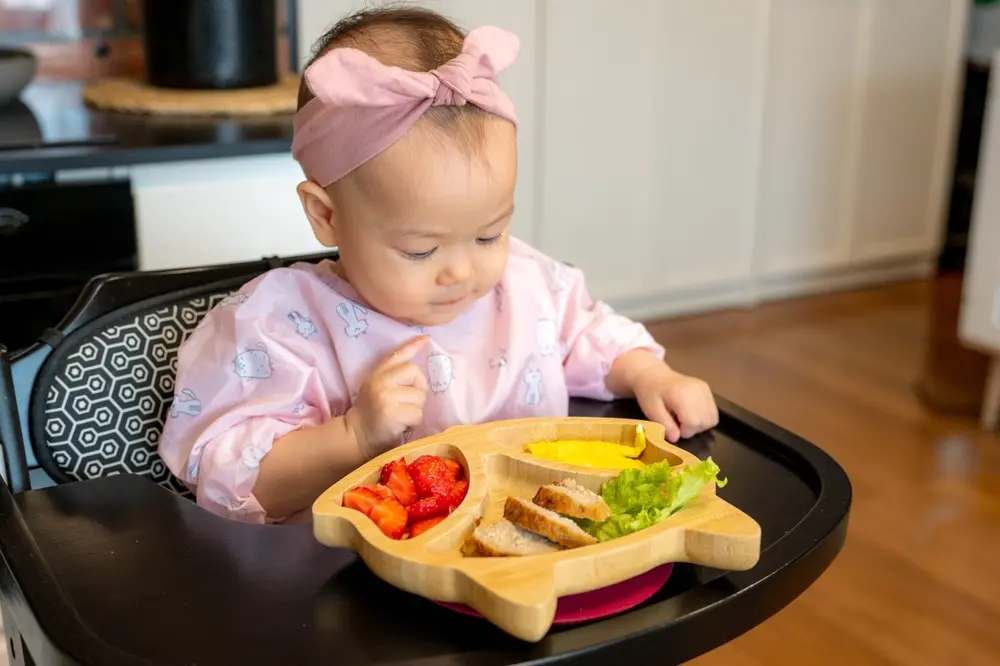
Introducing solid foods to babies is one of the most exciting milestones in their early development. It’s a journey filled with curiosity, adorable messes, and perhaps a touch of uncertainty. As a parent, you might be asking yourself: Where do I begin? What foods are best? How can I make this transition smooth and enjoyable for both of us? Don’t worry—you’re not alone, and we’re here to guide you every step of the way.
Tiny Taste Buds
In this step-by-step guide, we’ll cover everything you need to know about introducing solid foods to babies. From recognizing readiness signs to choosing the best first foods and setting up mealtime routines, you’ll have all the tools you need to make this process a success. Whether you’re a first-time parent or just looking for a refresher, this guide will help you and your little one navigate this exciting new chapter with confidence and ease. Let’s dive in and get those tiny taste buds ready for their first adventure!
Introducing solid foods to babies: Step-by-step
1. Check for Readiness Signs Before introducing solid foods to babies, ensure they show readiness signs. These include sitting up with little to no support, holding their head steady, and showing interest in food by watching others eat or reaching for food. Another indicator is a decrease in the tongue-thrust reflex, which pushes food out of their mouth. Babies typically reach these milestones around six months. Observing these signs is crucial, as starting solids too early can pose choking risks or strain their immature digestive systems. Always consult your pediatrician if you’re unsure whether your baby is ready for solids.
2. Start at the Right Age The ideal time to start solid foods is around six months, as recommended by most pediatricians and health organizations. By this age, a baby’s digestive system is more developed, and breast milk or formula alone may no longer meet their nutritional needs. Some babies may show readiness slightly earlier, but introducing solids before four months is not recommended. Starting solids too early or too late can impact a baby’s growth and development, so timing matters. If you’re unsure, consult your pediatrician for personalized advice tailored to your baby’s development.
3. Choose the First Foods Wisely Select simple, single-ingredient foods to start. Iron-fortified cereals, such as rice or oatmeal, are popular first choices due to their nutrient content and mild taste. Pureed vegetables like carrots or sweet potatoes, and fruits such as bananas or pears, are also excellent options. Ensure the food is smooth and free of added salt, sugar, or spices. Introducing nutrient-rich foods helps your baby develop a taste for healthy eating. Start with one food at a time, allowing your baby to adjust to new flavors and textures gradually.
4. Introduce One Food at a Time When introducing solid foods to babies, offer one new food at a time and wait 3–5 days before trying another. This gap allows you to monitor for allergic reactions, such as rashes, vomiting, or diarrhea. If you suspect a reaction, consult your pediatrician immediately. Begin with foods less likely to cause allergies, such as vegetables and fruits, before introducing potential allergens like eggs or peanuts. Keeping a food diary can help track your baby’s preferences and reactions, ensuring a safe and enjoyable feeding experience.
5. Create a Comfortable Feeding Environment Set up a calm, distraction-free area for mealtime. Use a highchair with proper back support to keep your baby seated upright, which reduces the risk of choking. Equip yourself with baby-friendly utensils like soft-tipped spoons and spill-proof bibs. Keep the atmosphere relaxed, as your baby will feed off your energy. Start with small portions and let your baby explore the food. A comfortable and stress-free environment encourages a positive association with eating and helps establish healthy mealtime routines.

6. Begin with Small Portions Start with small portions when introducing solid foods. A teaspoon or two is sufficient for the first few attempts, as your baby is still learning to eat. Gradually increase the amount as they become more comfortable with the process. Remember, breast milk or formula remains their primary source of nutrition, so solids are supplementary at this stage. Watch your baby’s cues, such as turning their head away or pushing the spoon, to understand when they’ve had enough. Be patient and let your baby set the pace.
7. Encourage Self-Feeding Once your baby shows interest in feeding themselves, introduce soft finger foods like steamed carrot sticks, banana slices, or baby puffs. Allowing them to hold and explore food not only fosters independence but also helps develop fine motor skills. You can also offer a baby spoon for them to practice with, even if it’s messy. Self-feeding promotes a positive relationship with food and builds confidence in eating. Supervise closely to ensure safety and prevent choking.
“Diverse tastes help expand their palate and reduces picky eating”
8. Be Patient and Observe Patience is key when introducing solid foods to babies. Not every meal will go smoothly, and it’s normal for babies to reject new flavors or textures at first. Offer foods multiple times in different ways to encourage acceptance. Pay attention to their cues—turning their head away, crying, or spitting out food might indicate they’re full or not ready. Avoid forcing them to eat, as this can create negative associations with food. Celebrate small victories and trust the process; every baby progresses at their own pace.
9. Offer a Variety of Textures and Flavors As your baby becomes more comfortable with eating, introduce a variety of textures and flavors. Gradually move from purees to mashed, and then to finely chopped foods. Exposing your baby to diverse tastes early on helps expand their palate and reduces the likelihood of picky eating later. Experiment with different fruits, vegetables, grains, and proteins, but avoid adding salt, sugar, or strong seasonings. The goal is to nurture a love for wholesome, nutritious foods.
10. Stay Alert for Allergic Reactions Introducing common allergens like eggs, peanuts, or dairy requires extra caution. Offer these foods in small amounts and watch for signs of an allergic reaction, such as hives, swelling, vomiting, or difficulty breathing. Introduce allergens one at a time and consult your pediatrician if you have concerns or a family history of allergies. Early exposure, under a doctor’s guidance, may even help reduce the risk of developing food allergies.

11. Include Iron-Rich Foods Iron is crucial for a baby’s growth and development, especially around six months when their natural stores begin to deplete. Offer iron-rich foods such as pureed meats, lentils, beans, spinach, and iron-fortified cereals. Pairing these with vitamin C-rich foods like tomatoes or oranges enhances iron absorption. Including a variety of iron sources ensures your baby gets the nutrients they need for healthy development.
12. Establish a Routine Incorporate solids into your baby’s daily schedule, complementing their regular breast milk or formula feedings. Start with one meal a day and gradually increase to two or three as they grow. Consistency helps your baby adapt to mealtime routines and signals that eating is an essential part of their day. Make mealtimes a family affair whenever possible, as this encourages healthy eating habits and social development.
“Including your baby in family meals helps them learn social cues”
13. Make Mealtime Fun and Relaxed Keep mealtime enjoyable by creating a relaxed and positive atmosphere. Sing songs, make silly faces, or let your baby explore their food with their hands. Avoid pressuring your baby to eat or reacting negatively to messes. A happy, stress-free environment fosters a lifelong positive relationship with food and encourages healthy eating habits.
14. Gradually Transition to Family Meals As your baby becomes more confident with eating, start offering them modified versions of family meals. Ensure the food is soft, appropriately sized, and free from added salt or spices. Including your baby in family meals not only makes feeding more convenient but also helps them learn social cues and develop table manners. It’s a natural progression that prepares them for eating a variety of foods.
15. Consult Your Pediatrician for Guidance Throughout the process of introducing solid foods, stay in touch with your pediatrician. They can provide personalized advice, address concerns, and ensure your baby is meeting their developmental milestones. Regular check-ins help you navigate this exciting stage with confidence and ensure your baby’s nutritional needs are met.
Try it yourself!
Introducing solid foods to babies is an incredible journey that sets the stage for their lifelong relationship with food. By following these steps, you can make the process enjoyable, safe, and enriching for both you and your little one. Remember, every baby is unique, so be patient and embrace the mess along the way. For more insightful articles and tips on nurturing your child, visit our Nurture category at hashtag-parentlife.com/category/nurture.



